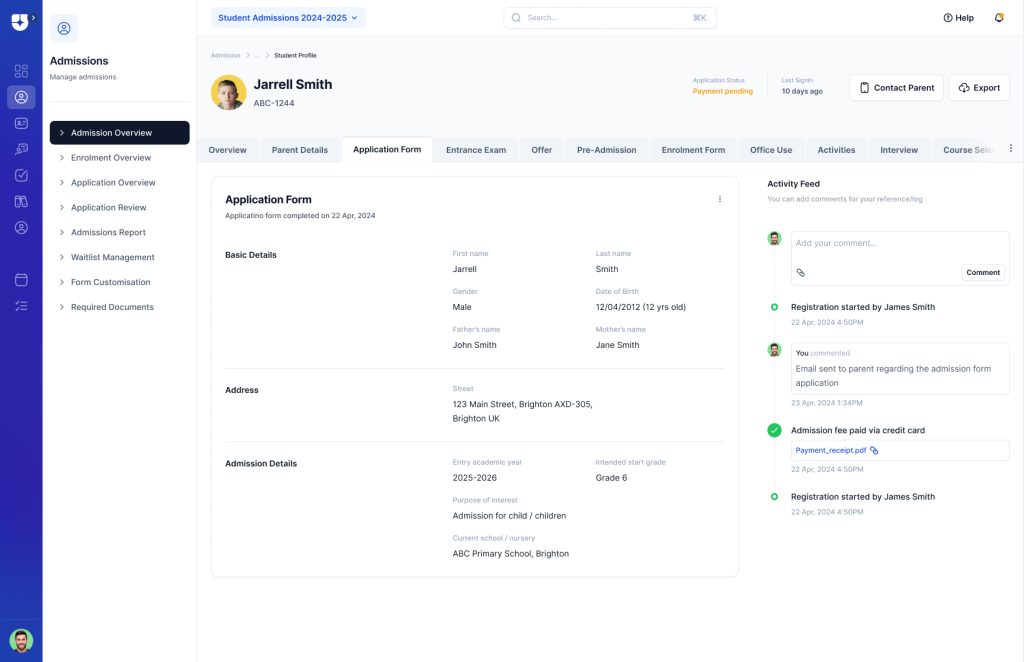Introduction

Digital transformation of schools is no longer a luxury—it’s a necessity in today’s fast-evolving educational landscape. From small primary schools to large academic institutions, the pressure to adapt to the digital age is both real and intensifying. School administrations, often the operational backbone of any educational institution, now find themselves at the forefront of this transformation. Their ability to adopt and integrate digital tools effectively can significantly influence how smoothly a school operates and how well it supports its pupils and staff.
This complete playbook is designed to help school leaders, administrators, and decision-makers navigate the journey of digital transformation for education with confidence—step by step—towards a smarter, more resilient school ecosystem.
What is Digital Transformation in School Administration?

Digital transformation in school administration refers to the strategic integration of digital technologies into all core administrative functions. This transformation goes beyond simply adopting a few new tools—it requires a fundamental shift in how schools operate, manage data, and interact with their stakeholders.
From automating attendance tracking to digitising fee collection, or from simplifying communication with parents to enabling real-time access to academic performance data—digital transformation reshapes every corner of the school’s administrative landscape.
Key Aspects Include:
- • Automation of routine processes (e.g., admissions, scheduling, reporting)
- • Real-time data access for quicker decision-making
- • Improved collaboration between departments
- • Secure digital records for students and staff
- • Scalable technology platforms to grow with the institution
Why is Digital Transformation Critical for Schools?

Digital transformation is not just about convenience—it is critical for the long-term success and efficiency of schools. Here’s why:
- 1. Efficiency & Time-saving
Administrative staff spend countless hours on repetitive tasks like entering data, processing forms, or coordinating schedules. By automating these tasks, schools free up valuable time and reduce human error—allowing staff to focus on higher-value activities such as strategic planning, student support, and stakeholder engagement. - 2. Improved Communication
Gone are the days of missed memos and fragmented parent-teacher communication. Digital platforms (like school apps, SMS portals, and parent dashboards) foster real-time, transparent, and traceable communication, ensuring that information reaches the right people at the right time. - 3. Data-Driven Decision Making
Having access to real-time data—whether on attendance, academic performance, resource allocation, or student wellbeing—allows school leaders to make informed, timely decisions. Trends can be identified, problem areas flagged, and interventions launched—all based on hard evidence rather than assumptions. - 4. Enhanced Data Security Digital systems come with robust encryption and access controls that protect sensitive student and staff information far more securely than paper files or unsecured spreadsheets. Compliance with regulations like GDPR also becomes more manageable with centralised digital records.
- 5. Future-Proofing the Institution
Embracing digital transformation lays the foundation for integrating emerging technologies like Artificial Intelligence (AI), Internet of Things (IoT), and Large Language Models (LLMs). Schools that adapt today are far better equipped to stay ahead of the curve tomorrow.
How to Successfully Implement Digital Transformation in Your School Administration
Step 1: Assess Your Current Administrative Processes
Before you can implement change, you need to understand where you currently stand. Begin with a full-scale evaluation of your school’s existing administrative workflows.
Consider:
- • Which tasks are still done manually? (e.g., attendance registers, handwritten notices)
- • Are there communication bottlenecks between staff, parents, and students?
- • Is your data stored across multiple systems, leading to data silos and duplication?
- • What are the current pain points for administrative staff?
This audit helps identify inefficiencies and reveals high-impact areas for digital transformation. For instance, if your fee collection process still involves cheques and paper receipts, digitising that function alone could drastically reduce time and errors.
Step 2: Define Clear Objectives and Priorities
Digital transformation without a clear vision can lead to wasted resources and fragmented systems. Set measurable, realistic goals based on your assessment.
Examples:
- • Reducing manual paperwork by 70% within 6 months.
- • Improving parent-teacher communication response times by 50%.
- • Enhancing data accuracy and reporting capabilities.
These objectives serve as benchmarks and guide the selection of tools, vendors, and implementation strategies. They also provide a clear way to measure ROI and build staff confidence.
Step 3: Choose the Right Technology Stack
Technology is not one-size-fits-all. Choosing the right tools is essential for successful implementation and long-term scalability.
Key Components:
- • School Management Systems: The central hub for tasks like student enrolment, timetable generation, attendance tracking, academic reports, and fee management.
- • Communication Platforms: Apps or portals that enable instant communication with staff and parents, issue alerts, or conduct virtual meetings.
- • Finance & Payroll Software: Automate payroll processing, budgeting, invoice tracking, and fee collections.
- • Data Analytics Dashboards: Visualise trends in student performance, staff workload, or resource usage to drive continuous improvement.
Look for solutions that integrate smoothly with one another, offer user-friendly interfaces, and provide technical support and training.
Step 4: Train and Empower Your Staff
No matter how good your education tech is, it’s only as effective as the people using it. Change can often be met with hesitation, especially if it feels sudden or complex.
Best Practices:
- • Provide hands-on training sessions tailored to each department’s needs.
- • Encourage a growth mindset—mistakes are part of the learning curve.
- • Appoint digital champions in each department to guide peers.
- • Create an open feedback loop to address concerns and improve adoption.
An empowered staff body not only embraces new tools but also helps drive innovation within the school’s culture.
Step 5: Implement in Phases and Monitor Progress
Rather than overhauling everything at once, take a phased approach to transformation. This allows you to test systems, gather feedback, and adapt quickly.
Recommended Rollout:
- 1. Start with high-impact, low-risk areas like digital attendance and fee automation.
- 2. Monitor outcomes using Key Performance Indicators (KPIs) like reduced processing time or improved accuracy.
- 3. Gradually expand to areas like reporting, analytics, and staff management.
- 4. Celebrate wins and communicate progress to boost morale and buy-in.
Regularly revisit your objectives and compare them against actual outcomes to ensure alignment.
Step 6: Foster a Culture of Continuous Improvement
Digital transformation is not a one-time project—it’s a long-term evolution. Build a culture where feedback, innovation, and experimentation are valued.
Encourage:
- • Periodic reviews of your tools and workflows.
- • Ongoing staff development in digital literacy.
- • Exploration of new trends such as AI tutors, predictive analytics, or virtual learning environments.
- • Sharing success stories across departments or campuses.
This kind of culture ensures your school stays agile, responsive, and future-ready.
Emerging Technologies to Watch
Keeping an eye on edtech trends can help you make smart, forward-thinking decisions.
Trending Technologies:
- • Artificial Intelligence (AI): Enables predictive analytics for student performance, automates administrative tasks, and offers personalised learning insights.
- • Large Language Models (LLMs): Useful for generating reports, answering queries via chatbots, and enhancing internal communication.
- • Cloud Computing: Offers scalable, secure, and accessible storage and collaboration tools.
- • Internet of Things (IoT): Supports smart classrooms, attendance via facial recognition, and real-time asset tracking.
Integrating these technologies requires a strong digital foundation—making your current transformation efforts even more vital.
Conclusion

The digital transformation of school administration is not just about upgrading tools—it’s about rethinking how schools operate to become more efficient, transparent, and impactful. By embracing the benefits of technology in education, schools can improve operational efficiency while fostering a more engaging and innovative learning environment. Using technology in education empowers educators to adopt innovative teaching methods and enrich the student experience.
By following this complete playbook, school leaders can chart a clear, confident path toward becoming future-ready institutions. Whether you’re just beginning your digital journey or looking to enhance what you’ve already started, remember: the goal is not perfection, but progress with purpose.
“Start now, start small—but start smart.”
FAQs
1. What does digital transformation in school administration really mean?
Digital transformation in school administration refers to the strategic shift from manual, paper-based systems to technology-driven processes. It involves rethinking how schools manage data, communicate with stakeholders, and carry out day-to-day operations using smart, secure, and scalable digital tools.
2. Why is digital transformation important for schools today?
It’s vital because it helps schools operate more efficiently, make better decisions through real-time data, improve communication with parents and staff, and future-proof their systems. In a world increasingly shaped by technology, digital transformation ensures schools remain relevant, responsive, and resilient.
3. What are some examples of digital transformation in schools?
Examples include:
• Automating attendance and admissions processes
• Using cloud-based platforms for academic records
• Enabling fee payments online
• Leveraging data dashboards for insights
• Implementing messaging apps for parent-teacher communication
These changes enhance transparency, speed, and collaboration across the school community.
4. Is going digital expensive for schools?
Not necessarily. While there may be initial costs for software or infrastructure, many digital tools lead to significant long-term savings. Schools save on printing, paperwork, postage, and staff time. Moreover, many platforms offer scalable packages suitable for various school sizes and budgets.
5. Will staff need technical training to adapt to new systems?
Yes, but it doesn’t have to be daunting. With hands-on training, clear guidance, and ongoing support, most staff members adapt quite quickly. Encouraging a growth mindset and involving staff early in the process makes the transition much smoother and more successful.

